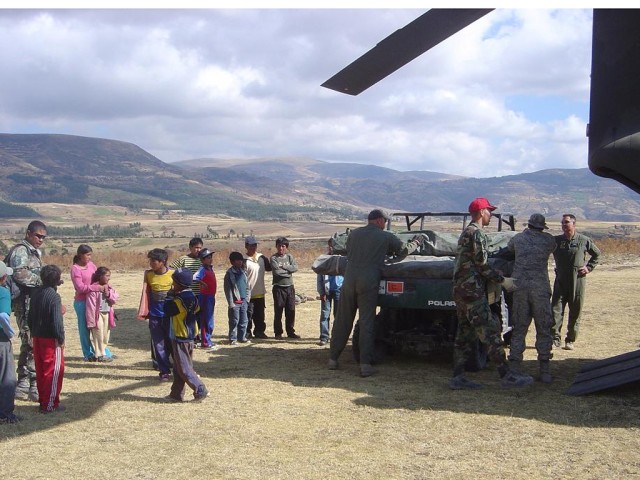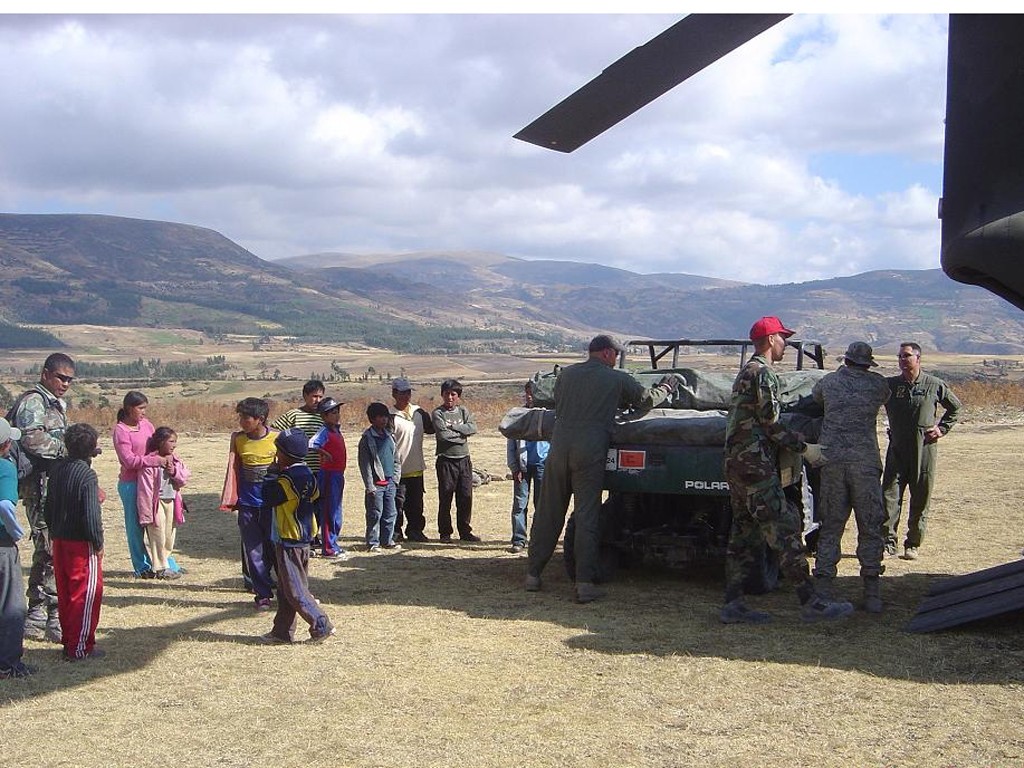AYACHUCHO, Peru -- U.S. Army CH-47D "Chinook" aircrew members and Soldiers with Task Force New Horizons are providing heavy-lift helicopter support to more than 990 U.S. servicemembers deployed to Ayacucho, Peru in support of New Horizons Peru-2008, a humanitarian effort focused on bringing a better quality of life to the people of Peru.
New Horizons is a U.S. and Peruvian partnered operation which includes the construction of t two schools, three clinics, and two waters wells, as well as nine medical missions.
The aircrews and support personnel, deployed from the 5th Battalion, 159 Aviation Regiment out of Fort Eustis, Va., are providing cargo lifting capabilities, troop transportation, and medical/casualty evacuation support during the New Horizon missions.
"In order for the Army to move large amounts of equipment, supplies and personnel quickly around the battlefield and to high altitudes, they need a specific capability," said U.S. Army Lt. Col. George Burbules, the New Horizons aviation task force commander. "The Chinook was designed just for that."
The Chinook's aircrews each consist of at least two pilots, a flight engineer, and a crew chief. Fully loaded this aircraft can weigh up to 50,000 pounds, and is capable of seating 33 combat loaded troops when flying at sea level. At the present altitude of 9,000 feet in Ayacucho, the Chinook is capable of carrying up to 20 people, and 8,000 pounds of equipment.
"Given optimum conditions, our Chinooks are capable of carrying 26,000 pounds of equipment externally," Burbules said. "They have also operated at altitudes as high as 15,000 feet."
The Chinooks are also on call in case of emergencies that require servicemembers to be transported back to base camp.
"It is essential for personnel to be brought either back to base camp or a local hospital," said U.S. Air Force Capt. Ronald Khoury, the Task Force New Horizons chief medical officer. "The Chinooks can transport patients from Huanta to Los Cabitos in about fifteen minutes versus a one to two hour bumpy drive.
Along with supporting the mission, the aviation teams have taken advantage of the training opportunities that can be found in the Peruvian environment.
"Our main goal is to support the global war on terror in either theater," Burbules said. "Flying in this environment allows us to train for missions in areas such as Afghanistan."
The aviators have conducted several high-altitude, dust and mountain landings, and progression trainings for the crew chiefs attached to the aircrews. During the progression training, crew chiefs are training on all objectives necessary to allow them to be promoted to a flight engineer.
"Our aircrews do not normally get the opportunity in the U.S. to fly in this kind of environment," said U.S. Army Capt. Derrick Llewellyn, the Task Force New Horizons flight operations officer. "It's a very valuable experience for our aircrews."
Also deployed with the aviation aircrews are their refueling teams, maintenance technicians and aircraft electricians. The fuelings team is responsible for ordering, receiving, issuing, and quality controlling the organic fuel for the Chinooks. Each Chinook is refueled after every mission
During the quality control tests, the fuelings team performs aqua glow and Millipore tests. During the aqua glow test, the fuel technicians test the amount of water contained in the fuel, and during a Millipore test, the fuel is tested for any particulate matter.
"This is a great learning experience," said Sgt. 1st Class Walter McKoy, the Petroleum, Oil, and Lubrication non-commissioned officer in charge. "Not only have we practiced refueling our Army aircraft in these conditions, but we've learned to refuel several Peruvian aircrafts as well, such as the MI-8 HIP helicopter."
While these soldiers are grateful for the rare training opportunities, they also recognize the value of participating in a humanitarian operation.
"I believe this is a great opportunity to help those in need," said Pfc. William Kelly, an aircraft electrician assigned to Task Force New Horizons. "It's nice to show the world that we are capable of humanitarian missions as well as war fighting."
To assist in building troop morale, the aircrews have also transported mail from the Peruvian embassy in Lima, Peru to Los Cabitos, the site of the U.S. base camp. The aircrews attempt a mail run at least once a week to bring joy to servicemembers separated from their family and friends.
"The aviators make the Task Force mission possible," said U.S. Air Force Maj. Matthew Joganich, the Task Force New Horizons commander. "Without them, we would not be able to medically evacuate sick personnel or pick up necessary supplies from Lima."
(Airman 1st Class Tracie Forte writes for Task Force New Horizons Public Affairs.)




Social Sharing